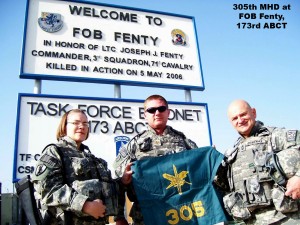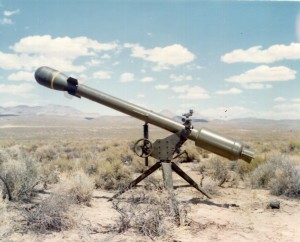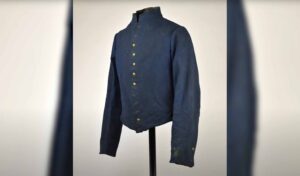In the U.S. Army, the term “division” has meant different things at different times. In the 18th and 19th centuries, it had usually been considered a temporary war headquarters of no set structure used to direct the regiments and brigades placed with it. In the twentieth century, however, a division received a set structure made up of various arms and services and became capable of sustained independent operations. The Army’s search for the most suitable division organization reflects its efforts to envision future enemies, adapt its fighting force to accommodate changing 20th Century technology, and resolve the battlefield realities of time, space and distance.
Following a dismal showing in the Spanish-American War, the Army re-examined its organizations and developed plans for a permanent combined arms division. The planners relied heavily on European experiences, even though European army planners focused at the corps level. Judging a 35,000-man corps too large, U.S. Army planners instead designed a division consisting of three infantry brigades, a cavalry regiment, an engineer battalion, a signal company, four field hospitals, and nine field artillery batteries, organized as a provisional regiment. The brigades provided two maneuver and one reserve element. An ammunition column, and a pack train were also added. The division had no fixed strength, but its march formation was planned to occupy no more than fourteen miles of road space. This represented a day’s foot march for the last troops in the column to reach the battlefront. The limiting design factors of the day clearly were those of time and distance.
As plans for the division evolved, the General Staff pioneered tables of organization for all types of units. Forerunners of those used today, the 1914 tables brought together for easy comparison a mass of information about unit personnel and equipment. These data, which previously had been buried in various War Department publications, greatly eased the task of determining mobilization requirements. In addition, the tables served as doctrinal statements and provided a systematic method for introducing new equipment into units. The Field Service Regulations that accompanied the tables defined the division as “a self-contained unit made up of all necessary arms and services, and complete in itself with every requirement for independent action incident to its operations.” As war raged in Europe in 1917, the War Department revised the structure of the division, but retained a triangular configuration to provide two combat teams for maneuver and one for reserve.
British and French experiences in World War I revealed that the American division lacked firepower and presented command and control problems because of its many small units. To overcome these difficulties, a new division was created with two infantry brigades (to reduce span of control), each with two infantry regiments, light and heavy artillery, signal and engineer troops, and service units. Such a division presumably would allow greater mobility, give the commanders the ability to exchange units in the line, and maintain battle momentum. Using this new concept, on 8 June 1917, the Army’s first permanent division, the 1st Expeditionary Division, was organized. Before the new division could be field-tested, however, the rationale for design changed. Army studies and European battle experience showed that instead of mobility, the division needed to emphasize the capability to fight prolonged battles. To sustain itself in combat, the division needed more, not less, combat power. The lack of experienced staff officers also made a smaller number of large divisions more practical. The revised divisional structure, officially adopted on 8 August 1917, was known as the “square division.”
Designed to conduct sustained frontal attacks rather than to maneuver, the square division was thought to possess tremendous firepower and endurance. The division’s firepower, however, proved less effective than hoped. The lack of reliable communications equipment and the difficulty of identifying the continually moving infantry units in the offensive hindered coordination between infantry and artillery, thereby slowing or halting the offensive. Furthermore, the French transportation network was overwhelmed by the logistics requirements for a square division. American divisions in the line suffered from shortages in food, ammunition, and other supplies. Part of the logistical problem also rested with the division’s lack of its own combat service troops.
Following World War I, the Army faced the question of retaining its divisions or returning to its pre-war regiments. Divisional planners also met the issue of who the next foe might be, and where. The war had clearly demonstrated the need for greater coordination among the arms and services, and the divisional organization was re-evaluated. A study group of former AEF officers endorsed the World War I square division concept and recommended that it be retained and adjusted as needed for maneuver warfare. Although General Pershing temporarily shelved their report, the War Department continued to explore postwar Army organizations. One of the findings was that an army stationed at small, scattered posts gave its officers no occasion to gain experience in managing large troop concentrations. Establishment of permanent divisions was proposed in which officers could have the opportunity to command large units and to train combined arms units for war, thus correcting a major weakness of past mobilizations. Congress agreed and required that the Army, as far as practical, be organized into brigades, divisions and army corps.
To execute the congressional directive an Army General Staff committee examined the structure of the division and again a square organization patterned after the unit of World War I was prescribed. Pershing objected, wanting a more mobile division with a single infantry brigade of three infantry regiments, an artillery regiment, a cavalry squadron, and support units. Pershing felt that the report unduly reflected the special circumstances of the Western Front. Summarizing the requirements for the infantry division, he wrote: “The division should be small enough to permit its being deployed from… a single road in a few hours and, when moving by rail, to permit all of its elements to be assembled on a single railroad line within twenty-four hours.” Again, time and distance factors, expressed in tactical terms, determined his concept of the future division.
Ultimately, a compromise emerged. The argument for three versus four infantry regiments in the division focused on the division’s probable area of employment, North America. Experts deemed another war in Europe unlikely and doubted that the Army would again fight on a battlefield like that seen in France. They felt technological advances in artillery, machine guns, and aviation made obsolete stabilized and highly organized defensive lines whose flanks rested on impassable obstacles, such as those encountered on the Western Front. Because of the poor road network and broken terrain of North America, the committee insisted that only the square division had sufficient mobility and striking power to fight in such an environment, although acknowledging it lacked the flexibility of Pershing’s suggested unit.
January 1929 marked the beginning of a ten-year struggle, dictated by events in Europe, to reorganize the infantry division. General Staff members reported that European countries were conceptualizing armies that could trigger a war of greater velocity and intensity than anything previously known. The British, French, and Germans were engrossed with “machines” to increase mobility, minimize loss, and prevent stabilization of the battle front. The British concentrated on mechanization and the French on motorization, while the Germans developed concepts that combined aspects of both. Concerned about the introduction of modern weapons and technology into European armies, Army planners undertook another division study. However, they were limited to using the vast stocks of World War I weapons and equipment, animal-drawn combat trains and motorized field trains in the design. Several proposals for a triangular division were made, but because of resource constraints, no divisions were reorganized.
In 1935, the General Staff examined the division again. Senior commanders were canvassed regarding organizational issues. Finding no consensus, the Army created a Modernization Board that, despite a broad charter, addressed only the infantry division. The end result of this study was the replacement of the square division with a triangular one. An infantry division with three combat teams simplified command structure and provided more flexibility. The elimination of the brigade echelon for infantry and field artillery enabled the division commander to deal directly with infantry regiments and artillery battalions. To assist in operating on a broad front, a cavalry reconnaissance troop equipped with lightly armored cross-country vehicles was assigned, and engineer, signal, quartermaster, military police, medical, and maintenance resources were provided. One of the more obvious changes was the elimination of animal transport, except in a few specialized cases. Later, when the airborne division was developed, it also was based upon triangular structure, but fielded fewer men and lighter equipment to accommodate existing aircraft – a variation of the space, distance, and time factors.
The triangular division did not prove to be completely satisfactory during World War II. It lacked all the resources regularly needed to operate efficiently, particularly tank, tank destroyer, and anti-aircraft artillery battalions. Although the Army’s concept was to provide these resources from corps level as required, shortages in tank and tank destroyer units made them unavailable to serve regularly with the same division. This resulted in considerable shuffling of attached units, which diminished effective teamwork. Divisional reconnaissance suffered because the armored-cavalry troop lacked sufficient strength and its vehicles were too lightly armored and armed for its mission.
The German Blitzkrieg in 1939 had a profound effect on the development of a new type division – the armored division. Testing of tanks and mechanized cavalry had been ongoing throughout the inter-war years on a limited level, but German successes and the U.S. Army maneuvers of 1939-40 resulted in the adoption of true armored divisions. This division was designed as a powerful striking force to be used in rapid offensive action, with a capability for sustained action. The first concept saw the division divided into five elements: command, reconnaissance, striking, service, and support. In 1942, this changed to two armored regiments under two combat commands, with a division artillery similar to that in the infantry division. Reorganization in 1943 eliminated the two armored regiments, leaving three tank battalions and three infantry battalions. A third command was added to control the division reserve on the march, but it became a third combat command. The armored division of 1942 was capable of more sustained action, but was weak in infantry. The lighter division of 1943 was more balanced in infantry, but needed an additional rifle company to form balanced tank-infantry teams.
After World War II the Army examined the infantry division again, seeking to fix weaknesses identified during the war. The division’s three regimental combat teams were preserved, with the addition of those units regularly attached in combat. One controversy that affected the development of the infantry division was the postwar battlefield’s greater depth and breadth. This “modern” battlefield made conducting reconnaissance and collecting intelligence much more difficult. The answer seemed to be aerial reconnaissance, and indeed ten airplanes had been assigned to the division artillery in 1943 to direct artillery fire. The Army Air Forces opposed the idea of organic aviation units in the division. Airmen argued that all air units had to come under their jurisdiction. No aviation unit was assigned to the postwar division, although ten planes were authorized for the field artillery and eight to the division headquarters company. The modified division structure of World War II was retained and increased to above 19,000 officers and enlisted men. As a result, the U.S. Army fought the Korean War with a modified World War II infantry division structure.
In the 1950’s Army planners thought a general war would be too costly to wage by conventional means because the Communist bloc could field more men and resources than the United States and its Allies. Tactical nuclear firepower appeared to be the answer. To achieve increased firepower with decreased manpower, the Army created the “pentomic” infantry division using five small battlegroups replacing the three infantry regiments. Conventional and nuclear artillery, tank, signal, and engineer battalions, and a reconnaissance squadron with ground and air capabilities were added, as well as a transportation battalion, an aviation company, and an administration company. The transportation battalion was to have sufficient armored personnel carriers to move an entire battlegroup at one time. The span of control was optimized in the division by giving each commander the maximum number of support elements that could be controlled effectively. The pentomic division was authorized about 13,500 men of all ranks, a reduction of nearly 4,000 from the 1955 infantry division. This divisional structure proved ill-suited for the requirements of the conventional battlefield given the communications technology of the late 1950’s, and the next reorganization of the 1960’s looked to the armored division, which had not adopted the pentagonal structure, as a model.
The new ROAD (Reorganization Objective Army Divisions) divisions called for infantry and armor maneuver battalions under three brigade headquarters, division artillery, aviation, reconnaissance, engineer, and signal battalions and a support command. Like combat commands in the armored division, the brigade headquarters had no permanently assigned units, but controlled from two to five maneuver elements and support units as the tactical situation dictated. With minimal adjustments to the ROAD base, by increasing and decreasing the number and type of maneuver battalions assigned to it, divisions achieved greater flexibility.
The flexibility of the ROAD concept permitted modern tanks, fighting vehicles, and field artillery weapons to be assigned to the divisions. Building upon the airmobile concept and combat experience in Southeast Asia, more helicopters were introduced to the division. An aviation brigade was assigned to the division for command and control purposes. Under the “come-as-you-are, fight-as-you-are” approach to war, combat service support had to be immediately available in the battle area. Therefore, units in the division support command were reorganized to include three support battalions, one for each brigade and a main support battalion to provide additional logistical support and health services for the entire division. Each combat arms brigade headquarters also received a dedicated engineer battalion. Within divisions, the trend was to provide more specialized units, which could then be attached to the brigades to form combined arms task forces. The division became a structured but flexible organization based on modular, interlocking building blocks.
The U.S. Army has had almost a century of experience in creating divisional organizations. Originally, time and distance as tactical factors determined division end strength. Later, concerns about strategic mobilization requirements dictated the size. Combat operations and the nature of a future enemy, especially the location of the next war, were especially influential in the 1920’s and 1930’s. As a large standing Army emerged after World War II, the existence of known potential threats led to divisional reorganizations, first the pentomic, and later the ROAD organizations.
Divisional organizations have fluctuated widely over the past century. It appears, with some variation, that the trend is toward smaller, self-sustaining units. Sustainment was the reason for the huge square division of 1918, while mobility and the demands of a two-front war in vastly different terrain mandated the more mobile triangular division, which also fought independently, augmented by corps and army assets. The smaller pentomic division was an attempt at mobility and dispersal that overreached itself. Lacking appropriate technology (communications and airmobility), the division could perform neither function. The more flexible ROAD division has proved extremely adaptable, not only to changing battlegrounds, but to major advances in doctrine, technology, and weaponry. Indeed, its success now enables divisional brigades to operate independently on the battlefield.
Technology and the changing nature of 20th Century warfare also have altered divisional structures. Technology, especially improved communications and weaponry, has enabled smaller units to execute missions previously thought suitable only for divisions. It may be no exaggeration to say today’s infantry battalion is the equivalent in firepower of the World War II infantry division. Distance and space factors hold less meaning today, when structuring divisions, because flexible designs and improved technologies enable forces to be tailored to meet specific missions.
Finally, although small units now are capable of conducting sustained operations, these units require an overarching structure to give cohesion to their parts. Independent brigades, for example, might become much like the fabled Army regiments of the late nineteenth century – individually magnificent, but, as demonstrated in the Spanish-American War, incapable of operating together. Therefore, the division likely will remain the basic warfighting organization, but its structure and organization must continue to be reassessed in terms of future battlefield innovations, as well as with an eye on the lessons of the past.
© The Army Historical Foundation





